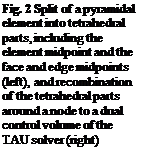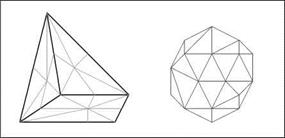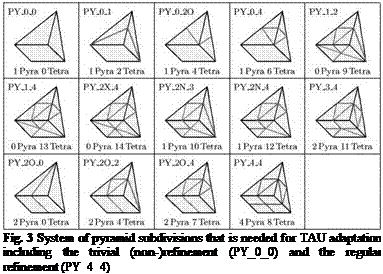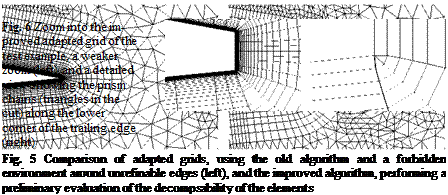Improvements Using the Decomposability of Elements
According to the red-green-type of refinement and the edge-oriented methods of the TAU adaptation, a lot of various types of element decompositons are needed for each element type. The decomposability of a special element means its geometrical characteristics which determine which subdivisions can be applied to this element. A special subdivision is applicable to an element if the resulting child elements are admissible for the TAU solver. Elements are admissible if they can be split into tetrahedral parts using the midpoints of the element, of the element faces and edges, see Fig. 2. Each of these tetrahedral parts has to have a positive volume, i. e. has to be correctly orientated, because the dual control volumes for the TAU solver are built out of them.
The problem is trivial for tetrahedra. Each tetrahedron with a positive volume has a mid point decomposition into positive tetrahedral parts. Furthermore, each refinement of a tetrahedron resulting from subdivision of some of its edges provides child tetrahedra with positive volume only. So even a very stretched tetrahedron has the full decomposability quality in this sense. This is not true for the other element types. Mainly because of nonplanar quadrilateral element faces, the similarity of the descendants and the initials does not hold as for tetrahedra.
 |
 |
Pyramids are not only part of bridging refinements between various hexahedra refinement levels, they also bridge between hexahedra and tetrahedra of hybrid grids and at prism sides in case of a varying number of prism layers. Thus pyramids have the most complicated system of subdivisions in the TAU adaptation, see Fig. 3. That is why the following consideration is done for the example of pyramids.
The admissibility conditions for the descendants of a special element subdivision can be expressed in terms of the edge vectors of the initial element. The vector analysis yields the corresponding conditions for the initial element needed to fulfill the decomposability condition for each single subdivision. The results of this investigation are presented in Tab. 1. The notation used in the formulation of the decomposability is introduced in Fig. 4.

In order to see how the exact knowledge about the possible refinements is used, some details of the adaptation algorithm are needed. There are two critical points: the first one is that most grids have some unrefinable edges, at least for the TAU adaptation. That can be the vertical edges of hexahedra and prisms of the structured and semistructured areas for resolving boundary layers. There are badly shaped
A WT^Pi ~
|
Table 1 Decomposability conditions for pyramids
|
elements which cannot be refined at all in some grids for complex geometries. Furthermore, depending on the TAU adaptation version, there are elements which have no implemented refinement, e. g. hexahedra apart from the boundary layers or hexa – hedra which cannot uniquely be assigned to one stack up to now.
The second point is that the initial edge refinement by the edge indicator runs through the grid to some extent. Starting from the initial refinement, additional edges have to be refined due to the red-green method and in order to preserve the layer structure at boundaries. Because not all element types have a subdivision case for each combination of marked edges, additional edges have to be marked in order to find a valid refinement case.
If this ongoing edge subdivision runs onto an unrefinable edge, the adaptation will fail with an invalid subdivision state for an element and crash. Earlier versions of the TAU adaptation used the following method to avoid this situation:
Earlier method:
1. Find unrefinable edges.
2. Mark all edges of a 5 elements deep environment around unrefinable edges as forbidden for initial subdivision.
3. Do the initial subdivision due to the edge refinement indicator for allowed edges only.
4. Loop over all elements:
Subdivide additional edges (including the forbidden and reflnable edges) until a valid refinement state is reached.
The depth of 5 not initially refined elements was needed for stability in application examples with repeated adaptation. In this way large parts of the refinable grid area were excluded from adaptation. The preliminary investigation of the decom – posability quality enabled the following improvement of the method:
Improved method:
1. Find unrefinable edges.
2. Check the decompositon quality for each element.
3. Loop over all elements:
Mark additional edges as unrefinable until each initial refinement leads to at least one valid refinement state.
4. Do the initial subdivision due to the edge refinement indicator for all refinable edges.
5. Loop over all elements:
Subdivide additional edges until a valid refinement state is reached.
The influence of the improved method was tested with a simulation of the flow around the HIRENASD wing. The initial grid was a SOLAR-grid [8] with 3.12 million points. After the solution was fairly well converged, the grid was adapted with 50% new points using the adjoint-based error indication and the integral drag coefficient as the target functional, see contribution Adjoint-Based Error Estimation and Functional Correction of this volume and Section 5. In case of adaptation to a target functional, the accuracy of the result for this functional is obviously a criterion for the performance of the adaptation.
The influence of the various refinement algorithms can be observed in a cut for y = 0 near the symmetry plane behind the trailing edge, see Fig 5. The adapted grid resulting from the earlier algorithm has much less points in this area. It can be supposed that this is due to the five elements deep environment of edges forbidden for the initial refinement.
A zoom into the grid around the trailing edge actually shows the unrefinable edges, see Fig. 6. The grid for the boundary layer consists of hexahedra stacks on the wall. They are depicted as quadrilaterals in the cut planes. But there are two stacks on the sides of prisms. These prisms are depicted as triangles at the lower corner of the thick trailing edge in the cut plane in the right side of Figure 5. The prisms alone would not prevent refining the attached hexahedra stacks. But the prisms form two chains along the trailing edge perpendicular to the cut plane and at the other end of

the prism chain, at the wing tip, a badly shaped pyramid is attached. Some edges of this pyramid are vertical edges at the same time.
The old algorithm starts at the unrefinable vertical edges, finds that the bad shaped pyramid only can be refined at once. Thus the entire pyramid is unrefinable. Because the TAU adaptation considers the attached prism chain as a stack, the corresponding edge stack would also be refined at once. Hence the algorithm which forbids the environment has to go through the prism chain in one step. Also, the algorithm has to go through the hexahedra stacks at the prism sides in one step. Finally it propagates into the tetrahedra area, affecting some of the neighbouring hexahedra stacks. Unfortunately this affects the whole trailing edge. The new algorithm does not need the five elements deep environment of forbidden edges. Therefore only the hexahedra stacks at the prisms are forbidden for initial refinement and not additionally the neighbour stacks and tetrahedra around them.
The results for the different adapted grids and the initial grid and for a globally refined grid as reference result are given in Table 2. The solution on the globally refined grid is a useful reference value for a solution on a once only locally adapted grid because the globally refined grid has in each region the best state which any local refinement could have regarding the resolution and element shapes.
The comparison shows that the drag is evaluated more accurately on the grid adapted using the improved algorithm. The result of the lift also is approximated better in comparison to the result on the initial grid. Because the target functional of the adjoint-based adaptation was the drag, the better adaptation algorithm does not have to result in a better approximation of the lift coefficient.
|
Table 2 Results of the test example
|











